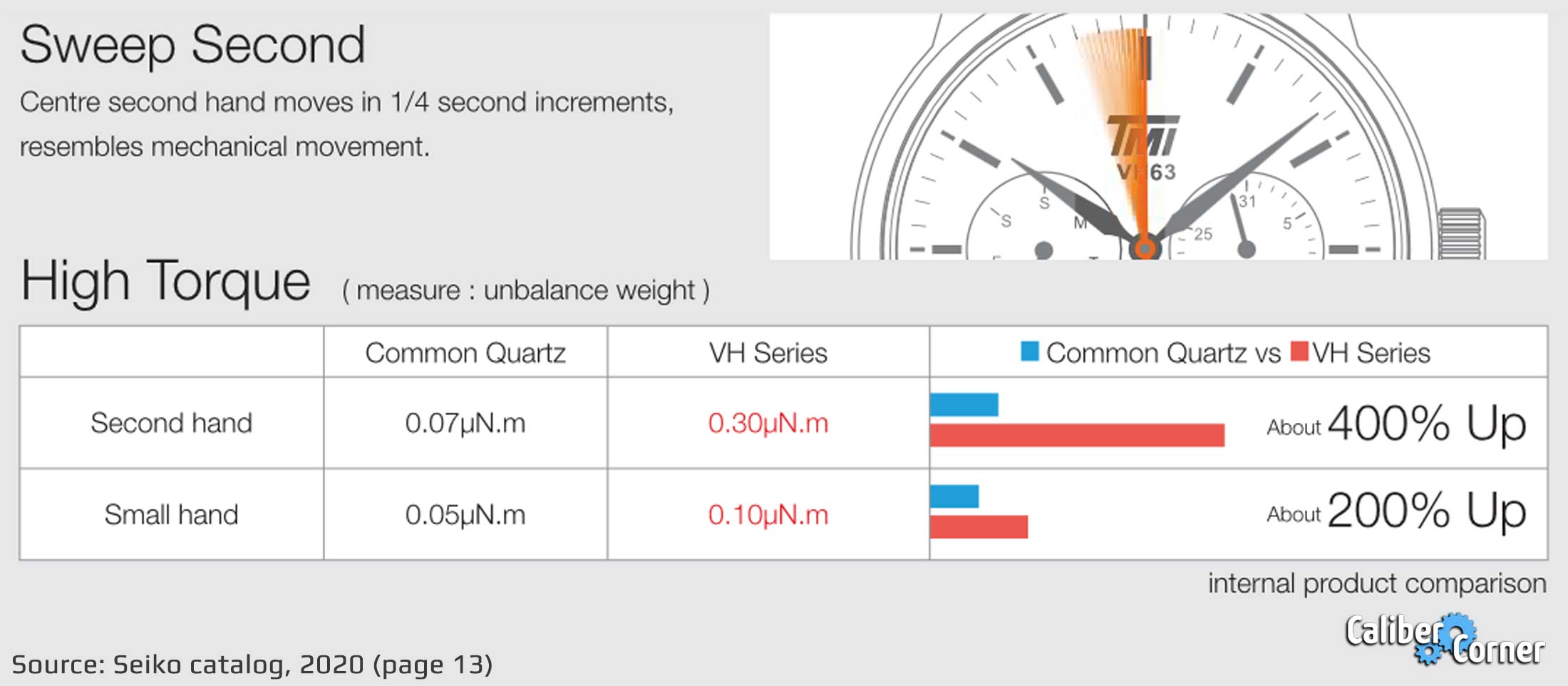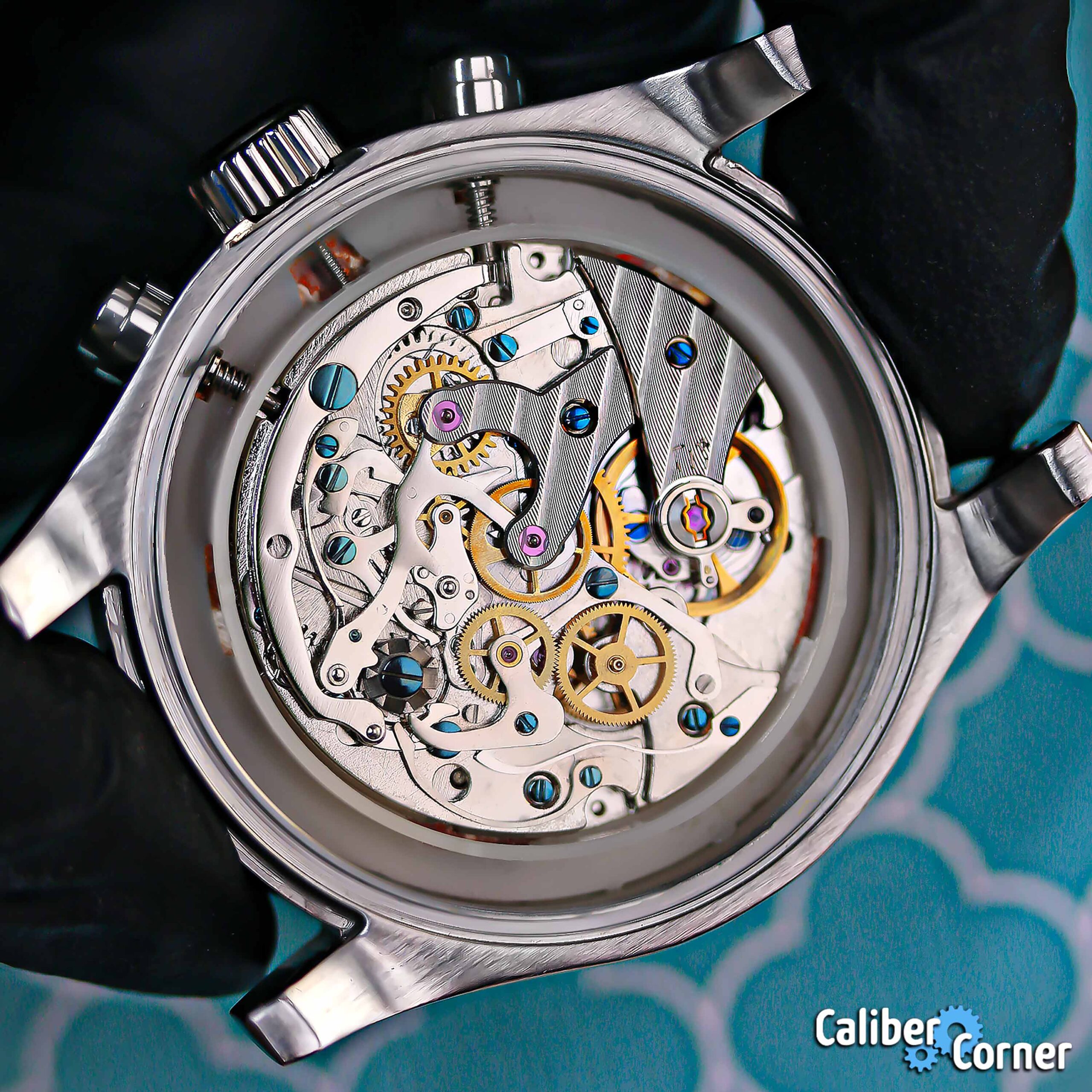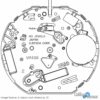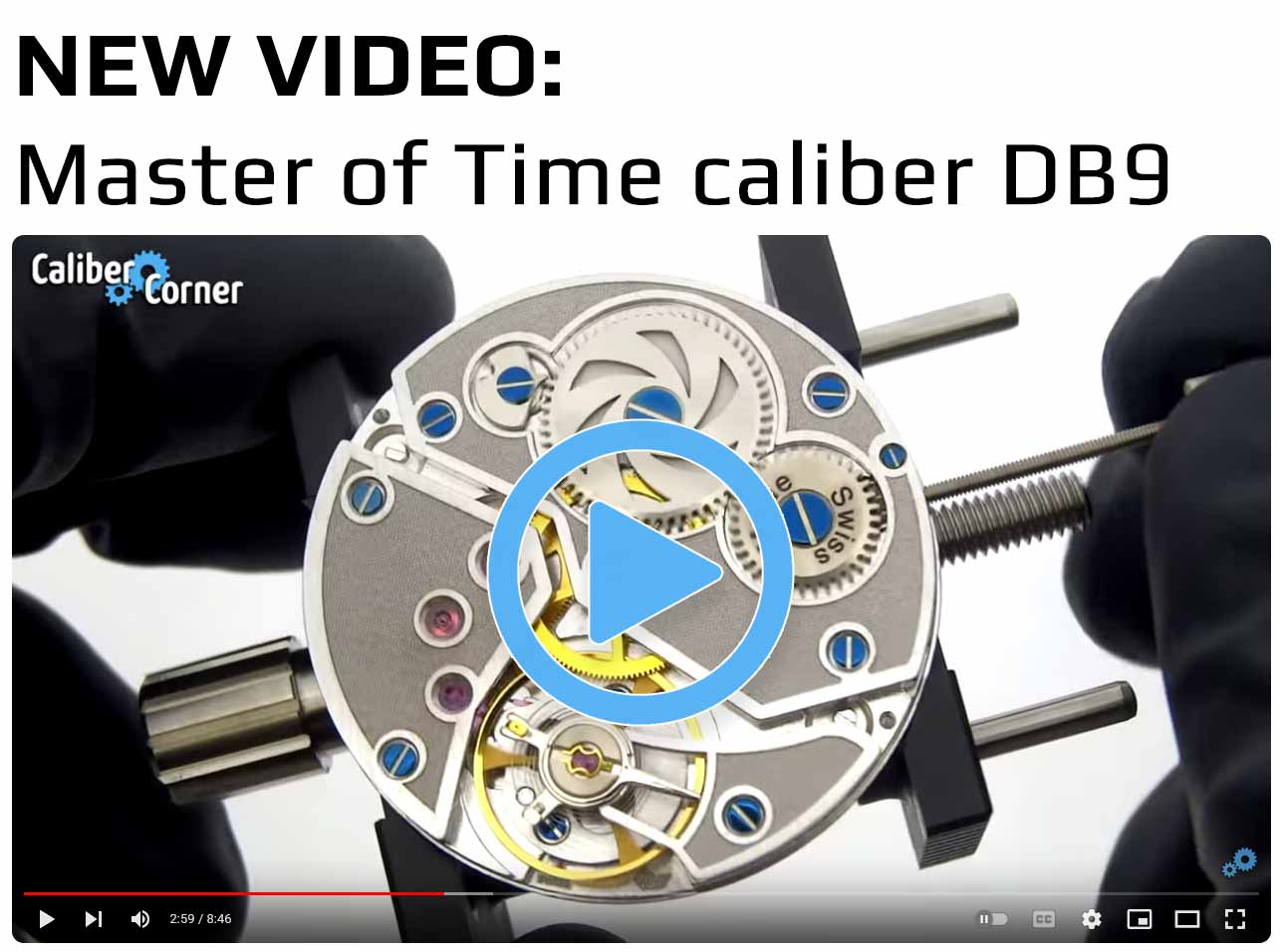Some of the topics covered in this caliber listing:
What is a mecaquartz watch?
Mechaquartz or meca-quartz typically refers to a chronograph watch movement that uses quartz technology for the main timekeeping functions of the watch, with a mechanical module for operating the chronograph – giving it a smooth sweeping like motion (similar to an automatic watch) and a snap-back style return to zero when resetting the chronograph. That is why these are often called hybrid movements – but is a hybrid movement different than a mecaquartz? Is a Seiko Spring Drive a mechaquartz movement? Let’s find out…
Before we continue, it should be noted that “mechaquartz” is not an official branding term used by Seiko or other manufacturers (Seiko is not the first and only brand to have mechaquartz movements, although today they are the most discussed).
At this point it is a community term designated for watches that either:
- Both mechanical and quartz in design, with functionality that resembles a mechanical watch.*
- A quartz movement that functions like a mechanical watch (such as having a sweeping seconds hand).*
While Seiko may not be the only company that has movements that check either of the boxes above, they have two lines of movements that do:
- VK – Premium Chronograph Series
- VH – Sweep Second Quartz Series
VK Premium Chronograph Movement:
Starting with the VKXX series, its relation to the mechquartz label comes from its Instant Zero Reset function.
In Seiko’s own words:
“VK premium chronograph movements are developed with the Three Pointed Hammer mechanism (once exclusive to our mechanical movements) to achieve the Instant Reset Function, a signature feature of mechanical chronographs.” -Source: Seiko/TMI official movement catalog, 2020 (page 2)
Based on this description, it makes sense if the first type of watches that comes to mind when discussing mechaquartz are the VK chronographs. You may find yourself thinking of how you can convert one of these movements to have a constantly running sweeping seconds hand. Well, no need for that because Seiko already thought of that with their caliber VH31 – a 3-hand caliber with central sweeping seconds hand.
But is the VH31 really a mecaquartz movement?
This can be a divisive topic in watches, and there may be some mechquartz purists out there who only want VK series watches to be blessed with the mechaquartz label, but a portion of the community has already staked their claim that the VH is also a mechaquartz movement.
Those who are adamant that the VH is not a mechaquartz, may have formed their opinion based on the marketing language Seiko/TMI uses to describe the VK series: “Quartz chronograph with mechanical action”, which isn’t clear if they are referring to the sweeping motion of the chronograph seconds or the instant zero reset motion. However, adding a little clarity, Seiko also uses the word mechanical to describe the VH series:
In Seiko’s own words with reference to the VH Sweep Second Movement:
“Centre second hand moves stably in 1/4 second increments, resembles mechanical movement” -Source: Seiko/TMI official movement catalog, 2020 (page 2)
Resembles mechanical movements, making the VH series just as worthy of the MECHAquartz categorization. This is also how the sweeping chronograph hand on the VK series works.
*These are not Caliber Corner’s official definitions, but one that become commonly used in the watch community, for example, even by brands using the VH31. While you may see comments on this site stating it is an error or flaw in the article, such comments should refer back to the many examples of reviewers, brands, and collectors using the term in this fashion.
To summarize:
- No official definition of the term by the manufacturers.
- “Mechanical” used to describe the two lines.
- Open to interpretation by the community.
How does mecaquartz work?
So if the “mecha” in mechaquartz is not so much for the actual mechanical aspect of the movement, then it is more for the appearance of how the movement functions.
Disassembly of a so-called mechaquartz movement presents a gear train, but non-mecha quartz movements also have a similar gear train. The gears are needed to move the analog hands. Digital quartz = no gear train needed, duh.
Taking the VH series movements as an example, they have a typical quartz frequency of 32,768Hz, but what makes it appear to have a sweeping seconds hand is a stepping motor that rotates (oscillates) four times per second. This is also where we get the beat rate of 14,400 vph, which is equivalent to a 2 Hz mechanical watch. (4 beats per second x 60 seconds x 60 minutes = 14,400)
Ultra high frequency movements also have a sweeping seconds hand, but are not as commonly referred to as mechaquartz by the watch community. This terms seems to have planted itself in the Seiko realm more than anything – perhaps because of Seiko’s use of the word mechanical when marketing their VH and VH calibers.
What is the correct spelling of mechaquartz?
Mecaquartz, mechaquartz, meca-quartz, mecha-quartz… are all used interchangeably, just pick one. There does not appear to be an official spelling outside of the top sites showing up on Google search for this topic (Caliber Corner being one of them). In fact, this type of movement is mostly associated with the Seiko calibers listed below, but even Seiko does not appear to use any form of this term on their website or in their marketing material (if you see them using it, please share below).
With that said, Caliber Corner is going with “Mechaquartz” as the official spelling from now on. It just makes the most sense as a combo of the words mechanical and quartz.
Pros of a mechaquartz movement:
A huge advantage that mechaquartz calibers offer is that they provide the accuracy and overall dependability of a quartz movement. Another advantage for watch designers is that they are much slimmer than a traditional mechanical movement.
Disadvantages of mecha-quartz movements:
An obvious disadvantage of mechaquartz is that they are battery powered.
Also, a major disadvantage of mechaquartz chronograph watches is that there is not hidden feature to reset the stopwatch hand to zero. One of the great things about quartz chronograph movements is the ability to reset the chronograph hand to zero after a battery install. Sometimes this can be a game of figuring out the correct crown/pusher sequence, but when you do, it can be quite satisfying! Mechaquartz movements do not share this ability. Since the stopwatch functionality is mechanically driven, the related hands cannot simply be reset via button sequence programming in the circuit board.
Also, replacing the chronograph hand on the VK series can be a problem. So much so that Seiko recommends installing a new hand if you remove the original one, rather than putting it back on. This is due to the torque of the return-to-zero action.
Then how do you reset mechaquartz chronograph hands to zero?
As mentioned above, unlike most quartz chronograph movements which have a setting coded into the circuit board (usually accessed by a certain sequence of crown position and button pushing), mechaquartz are more mechanical in nature. Similar to misaligned hands on an ETA caliber 7750 or other mechanical chronograph movements, most times the only remedy to get the hands back to 12:00 is to remove them and install them again in the correct position. One should also figure out what caused the hands to out of alignment in the first place – did the watch come like that from the manufacturer (low QC)? Was it dropped? Is it loose?
Caliber Commentary:
From wornandwound:
But it’s Seiko we have to thank for taking the meca-quartz idea and making it their own at a price that doesn’t cause a squeal. The cals. VK63, 67 and 83 are powering all sorts of watches from the likes of Autodromo to, well, Seiko.
…Sneak a look inside and you’ll see that the VKs use proper levers, hammers, wheels and heart pieces. Push the top button and you get a crisp, mech-style snick and the chrono steps off smartly, ticking in 1/5 sec increments—just like a mech. Push the stop button at 4 o’clock and you get the same crisp, mechy snick as the chrono stops. Press it again and the hand snaps straight back to 12. If I hadn’t let you in on the secret, you might just think you had an auto on your wrist.
Autodromo uses the Seiko caliber VK63 movement in their Prototipo model and calls it a “true mechanical reset chronograph.”
Here is what they say about it:
…Powered by an innovative Seiko hybrid meca-quartz movement, the Prototipo features a sweep second hand and instant chronograph reset thanks to internal mechanical linkages shared with Seiko’s in-house automatic movements. Prototipo delivers the reliability and precision of a quartz watch, with the crisp pusher feel and visual delight of a mechanical chronograph.
Dan Henry uses the VH31 in some of their watches, and here is how they describe it:
“Meca-quartz Seiko Japan cal. VH31 with smooth sweeping motion seconds hand (14.400 VPH)”
Popular mecaquartz calibers*:
- Seiko (SII/TMI) VH31
- Seiko (SII/TMI) VH60
- Seiko (SII/TMI) VK61
- Seiko (SII/TMI) VH63
- Seiko (SII/TMI) VH64
- Seiko (SII/TMI) VH65
- Seiko (SII/TMI) VH67
- Seiko (SII/TMI) VH68
- Seiko (SII/TMI) VH83
- Seiko (SII/TMI) VH88
- Seiko (SII/TMI) VK63
- Seiko (SII/TMI) VK64
- Seiko (SII/TMI) VK67
- Seiko (SII/TMI) VK68
- Seiko (SII/TMI) VK73
- Seiko (SII/TMI) VK83
- Seiko 6T63
- Seiko 8T63
- Seiko 8T68
*Depending on your definition, of course 😉
Some watches that use mecaquartz movements:
- Seiko SSB Series
- Techne Sparrowhawk 2
- Helgray Meca-Quartz Chronograph
- Autodromo Prototipo
- Mercer Brigadier
- Red Line Fast Track
- Dan Henry 1975
- Wolbrook Skindiver WT Mechaquartz
- Add your watch to the comments below…




 network of watch sites
network of watch sites












Recent Comments
I really wish that you would stop spreading the false information that the C07.111 etc.…
Found in Bulova Super Seville Day Date
Mine is very stiff.
Hi Xcaliber, various tap sizes are available. Tap size refers to the diameter of the…
Why two stems? 35117/tap10 or 351892/tap 11
Squale Y1545 GMT 30 Atmos Tropic
Aragon has been bringing back this movement.. this is the 45mm DiveMaster Titanium with full…